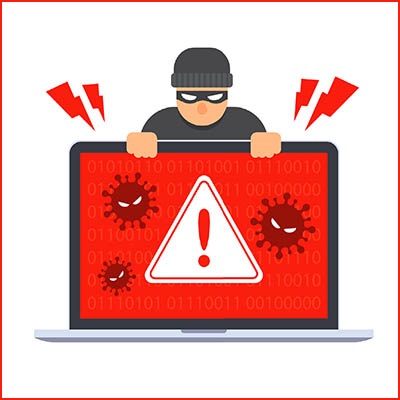It’s an ugly fact but online threats and cybercrime are flourishing, which means that IT security should be a top priority for all businesses. There have been some high-profile ransomware attacks, where company data is held hostage. This can put a company out of business almost overnight. Are you on top of online security for your business? We’ve compiled a list of security threats that every business should take very seriously.
Common Threats to Your IT Security
If you think that online security is just about viruses and malware, think again. Our list includes nine threats that regularly cause problems for businesses. You can never be one hundred percent sure that your IT security measures will offer complete protection, so it’s well worth preparing yourself for what could happen if something slips through the net.
Virus Infections
Viruses are top of the list for a reason – because they’re very common threats to computer security. Some are merely annoying, but others can completely disrupt your systems and stop your business in its tracks. They are just bits of code, but they can spread widely, corrupting data, destroying files and generally wreaking havoc. They’re easy to acquire. Free apps and software may contain viruses, as may files you download, including email attachments. Clicking on a bad link or an infected advertisement can also launch a potentially dangerous virus.
The good news is that developers have worked hard to create antivirus software that’s very good at offering virus protection. Because viruses are emerging all the time it’s important that it’s kept up-to-date and, ideally, protects in real-time. Businesses are advised to have a centralized antivirus solution on their network that will cover all the computers and peripherals attached to it.
Malware
The name malware refers to malicious software. Viruses are a simple type of malware, but there are lots of other more complex and nastier varieties of malware out there. It includes things like spyware, for covert observance of computer activity and data theft, or adware, for intrusive advertisements.
Malware is often installed on devices without your knowledge and can run more or less undetected in the background, even while it causes all sorts of problems. Malware spreads in the same way that viruses do. On the plus side, antivirus software typically works to identify and neutralize malware as well as viruses.
Phishing
A phishing attack can be one of two things. It’s a method to spread other types of attack, often consisting of spam messages with infected attachments or dangerous links that the recipient is encouraged to open, causing the device to become infected. They are often low-visibility and users don’t even notice what has happened.
Another type of phishing attack is when users are persuaded to either reveal confidential information, such as bank account details, or to send money to cybercriminals. These cybercriminals are sophisticated operators. They may forge authentic-looking emails, using addresses that seem entirely legitimate, and use clever persuasion techniques to influence users to respond. Phishing is a very common tool used by hackers and you should be on the alert for this type of scam.
Ransomware
This is one of the most dangerous cybercrimes. Ransomware takes over an organization’s files and encrypts them so that they’re impossible to unlock unless the victim pays a ransom. Usually the cybercriminals demand cryptocurrency for payment. If a company has a good backup for their data this may deter them from paying up, so a recent tactic used by the hackers is to threaten to release the data on the internet for all the world to see.
DDoS (Denial of Service) Attacks
A Distributed Denial of Service attack is when a network of infected computer (known as a botnet) sends such a high volume of traffic to a target server that it overloads and is forced to shut down. This can happen to websites or online services, and businesses are easy targets.
Trojans and Backdoors
These work by invading a device and then working silently in the background so that hackers can gain access down the line. That access can be used to steal data, install other malware or infiltrate a company’s network. With a backdoor installed on your network, a hacker can enter at any time they choose and carry out whatever criminal activities they wish.
Zero-Day Vulnerabilities
Cybercriminals are regularly creating new online scams and ways to breach computer security. When developers discover these, they devise and issue patches that plug the security gap that the hackers are using. The problem is that when a patch is issued, cybercriminals are alerted to the vulnerability that the patch is designed to fix. They can take advantage of this because not everyone will install the patch straightaway, leaving a window of opportunity for cybercriminals to strike. The way to avoid falling prey to this problem is to keep your software and antivirus programs up-to-date and keeping an eye on your network for any issues that may arise.
At Quikteks we know how important it is for businesses to be aware of the threats to computer security that are circulating and evolving. We can equip your business with the tools you need to keep your IT infrastructure secure. For more information, call us at (973) 882-4644.

